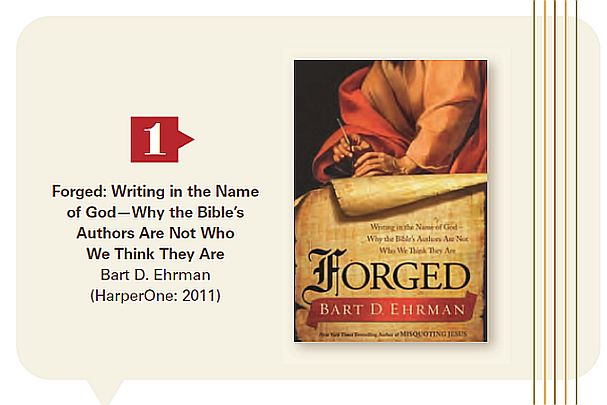A book review of
Forged: Writing in the Name of God—Why the Bible’s Authors Are Not Who We Think They Are
by Bart D. Ehrman
(HarperOne: 2011)
This article first appeared in the Christian Research Journal, volume 34, number 6 (2011). For further information or to subscribe to the Christian Research Journal please click here.
The most recognized evangelical-turned-agnostic in the world today, Professor Bart Ehrman of the University of North Carolina at Chapel Hill, has written yet another provocative trade book hostile to the Christian faith. Forged takes head-on the authorship of many of the books of the New Testament (NT), arguing that the ancient church got it wrong on most of them.
The book has eight chapters that, at first glance, look like discrete units. This gives the impression, reinforced by the subtitle to the work, that Forged marshals hundreds of pages of evidence that the writings of the NT are forgeries. But there is extensive overlap between most of the chapters. Forged is, furthermore, primarily about books other than the NT: forgeries in early Christianity written both by the orthodox and heretics, other Greco-Roman forgeries, even modern forgeries. To the undiscerning reader, Ehrman’s relentless revelations about ancient forgeries will seem like rock-solid arguments—by their sheer volume—for NT forgeries.
Ehrman’s argument that there are forgeries in the NT is threefold: First, the ancient church always rejected pseudepi – graphical writings (or forgeries) whenever they were detected as such. Second, sophisticated computer-generated statistical tools have demonstrated that Paul, for example, did not write the pastoral Epistles, 1 and 2 Timothy and Titus. Third, there is no evidence that the secretaries for any ancient letters had any role other than to copy down what the author dictated. They did not do any significant editing, nor were they coauthors or composers of these documents.
If Ehrman is right, we would need to toss out several books of the NT: Ephesians, Colossians, 2 Thessalonians, 1–2 Timothy, Titus, James, Jude, and 1–2 Peter. That’s ten letters assigned to the flames, since, according to Ehrman, the real authors of these letters deceived their readers into thinking that they were someone else. An examination of Ehrman’s arguments and evidence is therefore in order.
Ancient Forgeries. What Ehrman has to say about forgeries in the ancient world and in early “Christian” circles (he includes Gnostics and other heretics under the rubric Christian) from the second century on is quite accurate and very informative. This is an excellent primer on why ancient forgeries were produced, what forgeries were produced, and what their contents are. Most of the book is actually about such non-NT forgeries.
What the subtitle of the book claims, however, is related only to the Bible: forgeries abound in the Bible. This, of course, is where the battle lines are drawn. Surprisingly, however, Ehrman sides with evangelicals against most liberal theologians for his main thesis—that the ancient church decidedly rejected any documents written in someone else’s name. This view has been held by evangelicals for a long time. Moderate and liberal scholars have rejected it, finding at best paltry evidence to support their claims that the early church embraced benign forgeries. In his important work, The Making of the New Testament Documents, evangelical NT scholar E. Earle Ellis discusses the possibility of benign forgeries. He concludes, “The hypothesis of innocent apostolic pseudepigrapha appears to be designed to defend the canonicity of certain New Testament writings that are, at the same time, regarded as pseudepigrapha. It is a modern invention that has no evident basis in the attitude or writings of the apostolic and patristic church” (p. 324).
In this regard, Ehrman has aligned himself with the historic evangelical position, though he never acknowledges this. Significantly, his argument against liberal scholarship on this point is that the evidence doesn’t support their view, even though their position would be what Ehrman often refers to as the consensus of critical scholars. That phrase is loaded: it essentially means the consensus of those people who normally agree with Ehrman on various issues regarding Scripture (hence critical). Rather conveniently, it ignores the great body of scholars who would disagree with him and with other liberal scholars. Indeed, if one were to poll all NT professors, there would be no consensus over the authorship of the pastoral Epistles, 2 Thessalonians, Ephesians, or Colossians (though for all of these letters most biblical scholars would see them as authentic). By reducing the pool to what Ehrman euphemistically calls critical scholars (as though evangelicals cannot be critical), he is able to shape public opinion by systematic misinformation.
Ehrman’s fundamental thesis, then, is refreshing in that it devours a sacred cow of liberal scholarship and puts the issue of the authorship of NT letters on an evidential basis. Finally, here is one liberal scholar with whom evangelicals can find common ground: If these books are not written by their purported authors, then they are intentionally deceptive and the early church was wrong to accept them. As some evangelicals have argued, if this is the case, such books must be expunged from sacred Scripture.
Ehrman puts himself at risk at this very point; he has to back up his assertions with other arguments that certain NT writings are forgeries. Major gaps in his presentation, however, are seen: nowhere, for example, does he discuss the patristic testimony about the authorship of the thirteen letters by Paul. Routinely, biblical scholars wrestle with internal evidence (indications within the disputed NT letters) and external evidence (patristic testimony). And it is here that the evidence is overwhelmingly in support of apostolic authorship: the unequivocal testimony of these ancient authors—some reaching back to the late first century—is that Paul wrote all thirteen NT letters that bear his name, Peter wrote 1 Peter, and John wrote 1 John. As for the rest, there is some doubt raised about authorship from time to time—particularly over 2 Peter—a fact that shows that the ancients were not duped dolts but engaged in reason and research on the matter.
The massive amount of forgeries written in the apostles’ names that Ehrman produces demonstrates that the early church looked at the matter cautiously, since none of these forgeries—or, in Ehrman’s view, only a few of these forgeries—made it into the canon. Ehrman never mentions that the overwhelming majority of orthodox writings throughout church history were not forgeries, while the same cannot be said for heretical writings. Nor does he mention that it is the orthodox who unmasked the forgeries of both the orthodox and heretics; as far as I am aware there is zero evidence of any heretical group admitting forgery for any of their own writings—despite the fact that heretical works allegedly by Thomas, Mary, Philip, Peter, and many other of Jesus’ disciples have been found.
Statistics on Writing Styles. So how does Ehrman attempt to prove forgery in the NT? He uses the traditional arguments that have been debated for centuries: differences in style, theological differences, and historical discrepancies. There is a ready answer to arguments that the authors of the NT are not those claimed (though never acknowledged by Ehrman); see, for example, the magisterial NT introduction by Donald Guthrie.
Ehrman, however, ratchets up the discussion with statistical analysis. After discussing only a part of the data (word usage) that makes up an author’s style, Ehrman concludes: “In almost every study done [in the last ninety years], it is clear that the word usage of the Pastorals is different from that in Paul’s other letters” (98). The documentation at this point cites but one author, Armin Baum, who argues, contra Ehrman, that Paul wrote the Pastorals! Further, Ehrman fails to mention the most recent sophisticated computer-assisted research by K. J. Neumann.1 After exhaustive computer analysis, Neumann concludes, “Christian authors, especially Paul, are not distinguished by the indices chosen” (i.e., Paul’s usage is not clearly distinguished in his letters since (1) other NT books fit into Paul’s style and therefore (2) Paul’s style is not clearly demarcated).2 Surely this is not the modern sophisticated statistical study that Ehrman is thinking of, but neither does he mention any in support of his views.
The Use of Secretaries in Writing Ancient Letters. A standard evangelical approach to dealing with the stylistic differences of, say, Ephesians, Colossians, and the Pastorals from the rest of Paul’s letters, is to argue that the secretary of these letters may have had a larger role than merely copying down via dictation what Paul said. Ehrman, however, argues: “Did the secretaries contribute to the contents of [Paul’s] letters?…Despite what scholars often claim, all of the evidence we have suggests that the answer is no. The same evidence applies to the authors of 1 Peter, 2 Peter, and in fact to all the other early Christian writers” (135).
Ehrman interacts in this section with but one author who makes the claim of heavy secretarial involvement, E. Randolph Richards, The Secretary in the Letters of Paul. While Ehrman denies that Richards has produced any evidence along these lines, Richards’ discussion of secretary as editor, coauthor, and even composer is actually replete with primary documentation (43– 56). In his section on the secretary as composer—a role that is significantly greater than editor or coauthor—Richards offers irrefutable evidence: he notes that, when Cicero was imprisoned, he asked his friend Atticus to compose letters on his behalf— letters that Cicero would never even see!
Now if Cicero could authorize a trusted secretary to compose letters in his own name, then surely the lesser deed of editing or coauthoring must also have occurred. And it is significant that in 2 Thessalonians 3:17 Paul says, “I, Paul, write this greeting with my own hand, which is how I write in every letter” (NET). In other words, Paul apparently never authorized a secretary to compose a letter in his name that he did not see, but he did employ secretaries as editors and virtual coauthors. That he would write something at the end of all his letters would be proof that the letter was genuine, and it would indicate that Paul had authorized its contents. It should also not go unnoticed (though Ehrman never mentions this) that the only letters disputed on linguistic bases in the Pauline corpus are those that were written toward the end of his life—after Paul had spent years with some companions who could be trusted to flesh out his thoughts on paper.
Ehrman offers many other arguments that cannot be addressed in a short review. I must conclude with a final observation. The fact that Ehrman has put forth a trade book rather than a scholarly treatise on ancient pseudepigraphy allows him the luxury of not having to deal with counterevidence or peer review. Nowhere does he cite Carson, Dungan, Ellis, Hengel, Hoehner, Kellum, Kenny, Köstenberger, Longenecker, Millard, Moo, Morris, Neumann, Quarles, Wilder, or countless other scholars whose research disputes his conclusions. To the unsuspecting layperson, Forged looks like a death knell to the NT canon. To those who labor in the discipline of NT studies, it looks like yet another sensationalist book from Ehrman that is heavy on rhetoric and light on facts. —Daniel B. Wallace
Daniel B. Wallace is professor of New Testament studies at Dallas Theological Seminary and Executive Director of the Center for the Study of New Testament Manuscripts (CSNTM). CSNTM travels all over the globe to photograph New Testament manuscripts and make the digital images available online. Dan and his wife Pati have four sons and one granddaughter.
Notes:
- K. J. Neumann, The Authenticity of the Pauline Epistles in the Light of Stylostatistical Analysis (Atlanta: Scholar’s Press, 1990).
- Ibid., 213.









